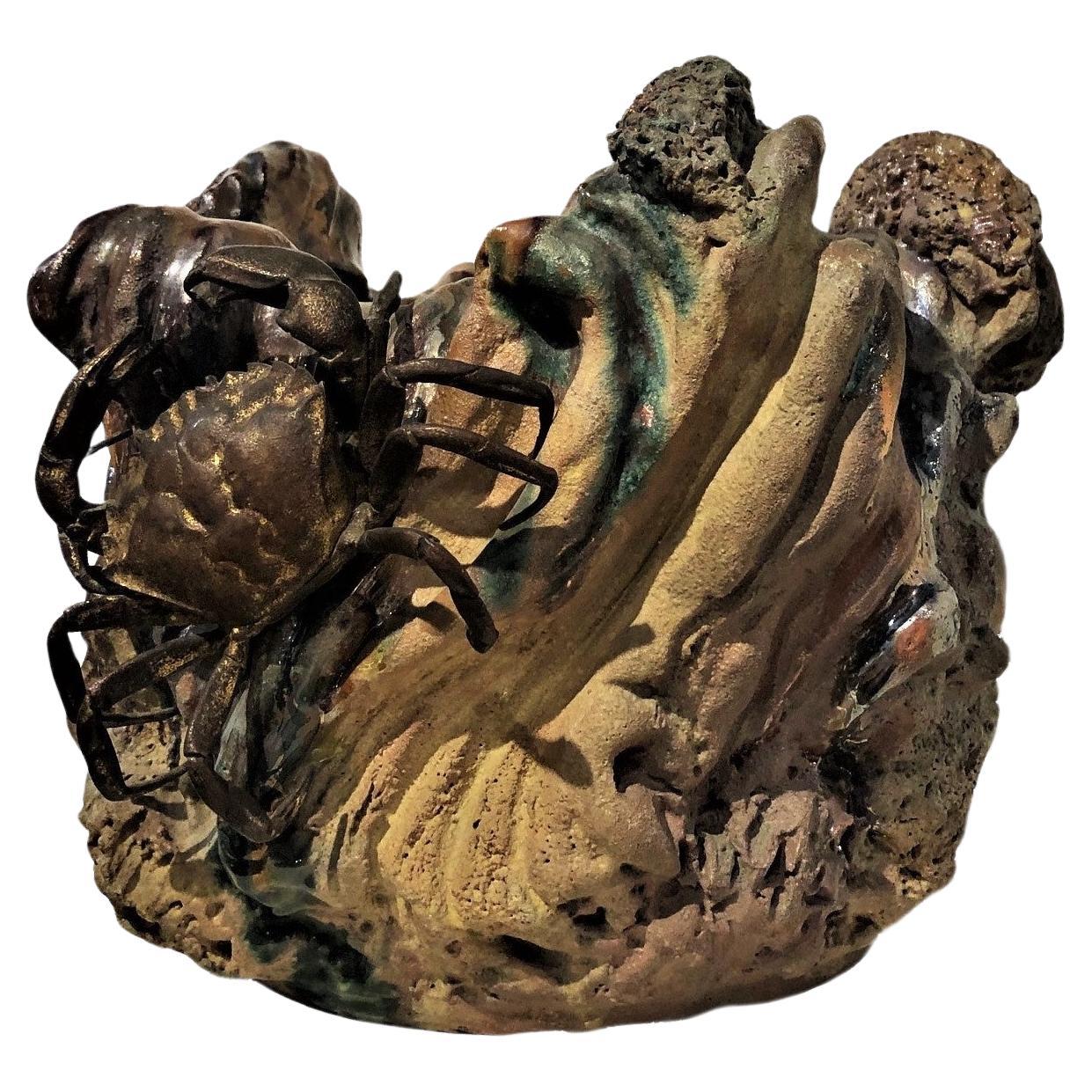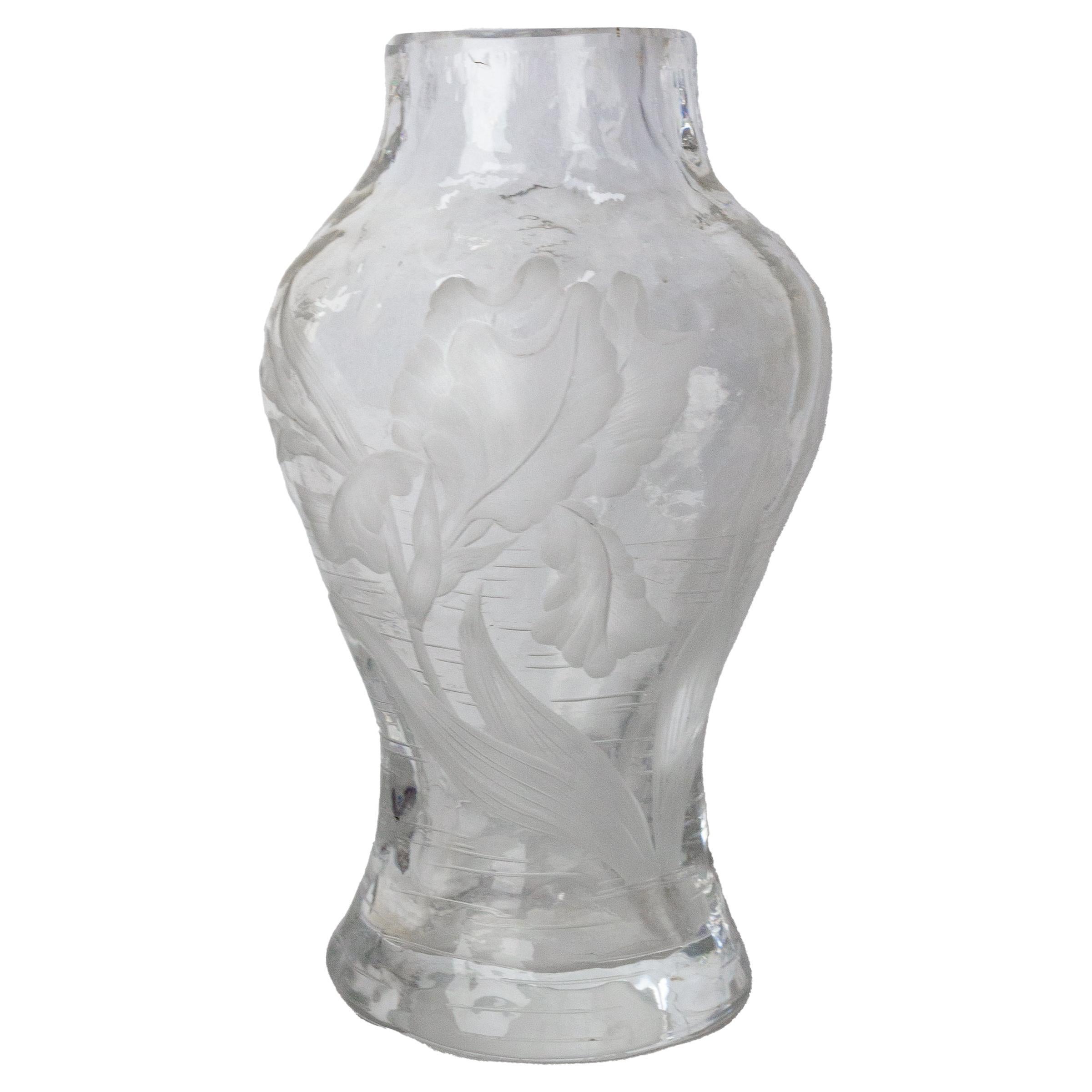Items Similar to French Art Nouveau Patinated Bronze Sculptural Iris Vase, ca. 1900
Want more images or videos?
Request additional images or videos from the seller
1 of 13
French Art Nouveau Patinated Bronze Sculptural Iris Vase, ca. 1900
About the Item
ABOUT IRIS
The iris is a special and mysterious flower. Not only because of its striking appearance, but also from an artistic and historical point of view. It is also like a work of art, as though created by Mother Nature. The unique leaves of this plant not only create wonderful shadow casts, but also look as if they were painted by hand. It's no wonder that iris acts as the muse for countless artists, and can be seen in many famous works of art.
The iris was first spotted in the time of Pharaoh Thutmose, in 1504 BC. He had the iris inscribed into the wall reliefs of a temple as a sign of his power, as well as decorating his sceptre with motifs of the flower. Since then, the iris has been a symbol of victory in Egypt. But the symbolism of the iris goes further than that. In Japan, the flower represents courage and is the symbol of the boys' festival. In Islamic cultures, the iris is a symbol of prosperity. In Europe, the flower was a popular weapon symbol in the Middle Ages and stood for chivalry. And in Christianity, the iris was seen as a symbol of the trinity because of its three-part flowers. With more than 300 varieties, the iris is now the most popular flower among growers and gardeners following the rose.
Countless artists use the iris in their works and the flower is present in all eras. You can see the flower on furniture, vases, jewelry, fabrics, sculptures, coats of arms and much more. Did you know that the iris is also called the sword lily? It's not a coincidence that it used to symbolize physical and emotional pain and suffering caused by a weapon. We also see the flower in religious art, where it's often associated with Mary and Jesus. The iris is also associated with the Greek goddess Iris, where the flower symbolizes reconciliation and divine messages. This is also reflected in many paintings.
Finally, the iris is also visible in Dutch and Flemish still-life paintings. This can be in a religious form, incorporated into an object or as a decorative flower.
In the Art Nouveau art movement, the iris (along with other plants, such as the birch) was often used as an expression of feminine beauty. With its almost otherworldly appearance, the iris is perfectly suited to the Art Nouveau aesthetic and is featured in many well-known works of art. The poet of that era, Hermann Hesse dedicated his fairy tale "Iris" (1916) to his wife. In the first sentence of the story, the poet made it very clear that the flower refers to feminine beauty.
- Dimensions:Height: 10.75 in (27.31 cm)Width: 8.5 in (21.59 cm)Depth: 8.5 in (21.59 cm)
- Style:Art Nouveau (Of the Period)
- Materials and Techniques:Bronze,Cast
- Place of Origin:
- Period:1900-1909
- Date of Manufacture:ca. 1900
- Condition:Wear consistent with age and use. We make our best effort to provide a fair and descriptive condition report. Please examine photos attentively, as they are an integral part of the description. Send us a message to request more details or discuss price.
- Seller Location:New York, NY
- Reference Number:1stDibs: LU2819331463462
About the Seller
5.0
Vetted Seller
These experienced sellers undergo a comprehensive evaluation by our team of in-house experts.
Established in 1993
1stDibs seller since 2017
68 sales on 1stDibs
Typical response time: 2 hours
- ShippingRetrieving quote...Ships From: New York, NY
- Return PolicyA return for this item may be initiated within 10 days of delivery.
More From This SellerView All
- French Art Nouveau Iridescent Stoneware & Bronze Vase or Cachepot, ca. 1900sLocated in New York, NYFrench Art Nouveau Ocean Life Theme Vase Cachepot Iridescent Stoneware & Patinated Bronze Crab Appliqué ca. 1900s ABOUT We present here a most unusual and utterly decorative Fren...Category
Antique Early 1900s French Art Nouveau Vases
MaterialsStoneware
- Japanese Art Nouveau Meiji Period Patinated Bronze Vase, circa 1900Located in New York, NYAlthough unmarked, this rare and important, grand but at the same exquisite patinated bronze vase has just a very few little details, defying the shape of the handles, as well as the...Category
Antique Early 1900s Japanese Art Nouveau Vases
MaterialsBronze
- Charles Vital-Cornu, French Art Nouveau Bronze Sculptural Floral Vase, 1900sBy Charles Vital-CornuLocated in New York, NYCharles Vital-Cornu (French, 1851 - 1927), Jouffroy’s and Pils’ pupil, he acquired a skillfulness mastery in carving marbles and producing bronzes. He used several patinas in his production. Indeed, if his pieces' embodiments are often golden-brown colored, the hollow part are darker. His figures, hands, faces, and bodies are of a great quality. Charles Vital-Cornu had participated in numerous annual ‘‘Salons’’ organized in Paris by ‘‘la Société des Artistes Français’’ where he got several awards, such as a mention of Honor in 1880 and 1881, a third class medal in 1882, a travelling grant in 1883, a second class medal in 1886, a bronze medal at the 1889 World Fair and, finally, a silver medal at the 1900 World Fair at the Grand palace...Category
Antique Early 1900s French Art Nouveau Vases
MaterialsBronze
- French Art Nouveau Grand Bronze Iris Candelabra, ca. 1900Located in New York, NYABOUT IRIS MOTIFS Iris motifs were popular during the Arts & Crafts movement. The genus of this easy-to-stylize flower has nearly 300 varieties that bloom in many colors—thus its nam...Category
Antique Early 1900s French Art Nouveau Candelabras
MaterialsBronze
- Paul Loiseau-Rousseau, French Art Nouveau Gilt Bronze Jug, Ca. 1900By Paul Loiseau-Rousseau 1Located in New York, NYPaul Louis Emile Loiseau-Rousseau (French, 1861-1927) was a famous French sculptor. In his youth, he planned to devote himself to etching, was a student of Antoine-Louis Barye at the...Category
Antique Early 1900s French Art Nouveau Vases
MaterialsBronze
- French Beaux Arts, Patinated Bronze Figural Vase by A. Bofill, Ca. 1900By Antoine BofillLocated in New York, NYAntoine Bofill (Spanish-French, 1875-1925) was a Spanish artist and member of the Animalier movement of the 19th century. Best known for his small, decorative bronze sculptures, Bofi...Category
Antique Early 1900s French Beaux Arts Vases
MaterialsBronze
You May Also Like
- French Glass Vase with Iris and Lacusted Decoration Art Nouveau, circa 1900Located in Labrit, LandesFrench art nouveau glass vase An iris is engraved in the foreground of a lacustrine decoration. Iris is one of the typical flowers of art nouveau representations Irregular vase...Category
Early 20th Century French Art Nouveau Vases
MaterialsGlass
- French Art Nouveau Bronze VaseLocated in Milano, ITBeautiful French bronze vase from the Art Nouveau period, made during the early 1900s, fine French manufacture. The vase is made entirely of bronze,...Category
Antique Early 1900s Italian Art Nouveau Vases
MaterialsBronze
- Art Nouveau Porcellain Vase with Neptun Sculpture, ca. 1900Located in Berghuelen, DEA nice antique porcellaine vase in typical Art Nouveau style. With a protruding Neptun sculpture on the body. With blue and brown glaces. Manufactured...Category
Early 20th Century German Art Nouveau Vases
MaterialsPorcelain
- Émile Gallé small Cameo vase, Art Nouveau, ca 1900By Emile GalléLocated in Delft, NLÉmile Gallé small Cameo vase, Art Nouveau, ca 1900 Émile Gallé (Nancy, 1846 –1904) was a French glassmaker and furniture designer Émile Gallé 20 cm hig...Category
Early 20th Century French Art Nouveau Vases
MaterialsGlass
- Émile Gallé Miniature Cameo Vase, Art Nouveau, Ca 1900By Emile GalléLocated in Delft, NLÉmile Gallé miniature Cameo vase, Art Nouveau, ca 1900 Émile Gallé (Nancy, 1846 –1904) was a French glassmaker and furniture designer Émile Gallé 7...Category
Early 20th Century French Art Nouveau Vases
MaterialsGlass
- Large Émile Gallé Art Nouveau Cameo Vase, Iris And Lily Pond, France, ca. 1906By Emile GalléLocated in Vienna, ATSlender baluster-shaped vase body on a separate base, widening conically towards the top and then narrowing again to form a slender neck with a flared mouth rim, colorless glass with...Category
Antique Early 1900s French Art Nouveau Glass
MaterialsGlass
Recently Viewed
View AllMore Ways To Browse
Antique Furniture Ca
Ca France
French Vase 1900
Striking Appearance
Art Nouveau Furniture Only
Antique Wall Vase
Antique Wall Vases
Religious Greece
Patinated Bronze Vase
French Relief Vases
Japanese Art Nouveau
Art Nouveau Japan
Garden Flower Vases
Antique Dutch Vases
Art Nouveau Fabric
Garden Vases France
Art Nouveau Vase Gold
Bronze Signed For Vase





